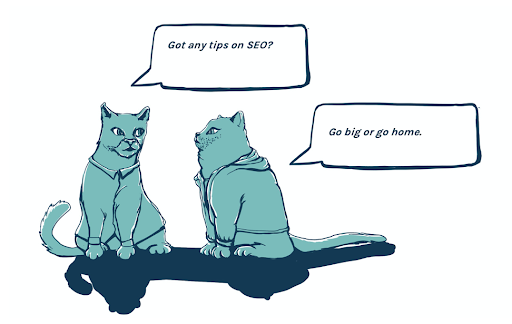Written by Rebecca van Laer
December 7th, 2021
Driving Traffic to Your Website Using the Best SEO Practices

Launching a new website or product page is like planning an epic party. You make sure your page is visually stunning, invite a few VIP guests, and do everything you can to spread the word. Then, you wait nervously next to that iced champagne waiting to see if people will actually show up.
After all, no matter how glitzy your website, it’s all for naught until potential customers actually come through your metaphorical doors.
So how can you ensure a packed venue? While paid ads are one potential route for driving traffic, 96% of consumers are distrustful of advertising.
The best way to persuade the ad-skeptics is by harnessing the power of Search Engine Optimization (SEO) to draw traffic to your website. In this guide, we’ll explain how to turn your website into a 24/7 click party using SEO best practices.
Plan the Guestlist With Keyword Research
The first step in driving traffic to your website is figuring out what your potential customers are searching for as they interact with search engines every day.
This all starts with keyword research.
Say you’re an eco-friendly party planning company launching your website. Your target audience is conducting a variety of relevant searches every day, including:
- Short tail queries – “Parties,” “event planning,” and “party supplies” are all potentially relevant to your brand. You’ll want to include these keywords in your content, but keep in mind that it will be difficult to rank for them, since local and national companies have been churning out relevant content chock-full of these keywords for years on end.
- Long tail queries – On the other hand, your target audience might also be looking up niche search terms like “eco-friendly party supplies” and “zero waste party catering.” These are both more relevant to your services and less competitive to rank for.
So, how do you figure out which keywords get your potential audience buzzing? You can start by brainstorming keywords relevant to your brand and product. Then, use free tools like Google Search Trends to see how many people are actually looking them up on a monthly and yearly basis.
But it’s sometimes helpful to enlist the help of a professional.
Keep in mind that unlike an IRL party, it’s almost impossible to invite too many people to your website. You’d have to go viral to generate enough traffic to crash your domain. So cast a wide net with search keywords, and prepare to implement them on your web pages and on blog.
Place Your Keywords Carefully for a Successful Invite
When you send out invitations, you know to include the most important details upfront: date, location, and time should all be evident at a glance.
The same is true for keywords—placing them in the correct places appeases search engines, while integrating them into engaging, authentic prose make sure your invitees keep reading.
So, where should those keywords go? Here are the best SEO practices for placement:
- Title Tag – Place your main long-tail keyword in a title tag of under 50 characters. Resist the urge to stuff in multiple keywords, as this can actually backfire (not to mention result in some seriously convoluted syntax).
- Meta Description – This is the short description that shows up under your title tag in search results. It should be under 156 characters and include your main long-tail keyword nestled inside a short, engaging description of what the page covers.
- Introduction – Placing your main keyword within the first paragraph of your article can likewise communicate its relevance to search engines (and make the reader feel like you’ll be fully addressing their query).
- Headings – Headings are a great place to include any secondary long-tail keywords. Just keep in mind that some keywords lack proper grammar and syntax, and these errors may stand out even more in super-sized heading text.
- Conclusion – For good measure, add a couple additional keywords (or repetitions of earlier keywords) in the conclusion.
There’s No A/V, But Technicalities Still Count
Technical glitches are every host’s worst nightmare. It’s hard to keep your guests in a fun-loving mood when the same track is on repeat, or even worse, the lights have gone out.
And when it comes to your website, small technical snafus can also affect your SEO performance.
For best results, pay attention to the following details:
- Image file name and alt text – Before you upload your files, make sure they have descriptive names that correspond to keywords. Likewise, give your images alt text. This ensures usability and supports your SEO strategy.
- Web urls – Creating a URL like “yourdomain.com/how-to-plan-a-party/” will yield better results than “yourdomain.com/dskj2349-q-44/”
- Site speed – If your site doesn’t load immediately, users will be out the door before you have a chance to captivate them with your content. Make sure your site is optimized for both desktop and mobile display.
Keep the Party Going With Quality Content
You’ve done everything possible to get people in the doors—but you’re not quite guaranteed success.
The next step is keeping readers on your page.
Fostering engagement and click-throughs is an obvious must for converting leads into customers. But creating high-quality content that makes people want to keep reading can actually support your SEO strategy.
But how?
It comes down to a couple of metrics: bounce rate and dwell time.
If your customers bounce within a second of arriving on your page, search engines assume you’re not providing relevant content. Conversely, if they dwell on your page for a while, it signifies to the algorithm that your page caters to their exact needs.
When it comes to your website itself, the goal is to create sleek, attractive landing pages that fully communicate your product and ethos. Attractive images and video can help to boost dwell time—so push your creative department on the line!
A successful SEO strategy will also include regular SEO-optimized blog posts of around 1500 words. How can you boost dwell time on your blog? Here are a few of our top tips:
- Get to the point in the introduction. Say someone Googles “how to plan a party on a budget” and lands on your page—only to find that your introduction is all about the history of New Year’s Eve celebrations. Do you think they’ll keep scrolling to find the answer? Exactly. To avoid early exits, address the topic as quickly as possible in the introduction while foreshadowing how you’ll flesh out that answer in the rest of the post.
- Structure information by relevance. Writing an article on “Average Cost of a Party?” After you address this query with a specific number in the introduction, make sure your next section heading is highly relevant to the topic. For example, “Factors that Affect Party Cost” is probably more important to your potential customer than a section on “Best Party Themes.”
- Make it engaging. You want to provide your prospective customers with the information they’re looking for—all while introducing them to your unique brand voice and point of view. That means infusing each post with the ethos and spirit of your company. On dry topics, this is easier said than done—which is where SEO Content Writing services can come in handy!
Plan For the Future by Tracking Your Results

Hopefully, the above tips are enough to help you launch a successful SEO strategy that has crowds lining up at your metaphorical door.
But keep in mind that implementing SEO once isn’t enough. To that end, consider that:
- Search algorithms reward sites that post content more frequently. If you’re a smaller brand with limited bandwidth to create new content, you should aim to post once or twice a week to keep search crawlers abreast of your site’s ongoing relevance. Want to scale up your traffic and outrank competitors? You might actually make it a goal to post daily.
- Posting more frequently also creates the opportunity to integrate internal links to your other pages and posts. If one page is ranking on Google, the engine will be able to crawl embedded links, forming a more robust understanding of your site (and boosting the likelihood that those linked pages will rank, too).
When creating new content, the goal is to build on your past success.
Use Google Analytics or work with your SEO partner to track the search terms that generate the most traffic and the longest dwell time. Then, identify how to create new content related to this topic, keeping in mind that you should never post duplicate content.
Cut Out the Uncertainty With Copycat Copywriters
Some call it the French exit; others call it “ghosting.” No matter what term you use to describe an uncourteous goodbye, you want your site to avoid this fate at all costs.
Follow the above tips for researching and placing your keywords, then work on crafting content that makes readers want to settle in and stay awhile.
Need help creating quality content that reflects your brand’s joie de vivre? We’re here to help. At Copycat Copywriters, we specialize in dynamic content that accords with SEO best practices while fostering deeper connections between readers and brands.
Consider this your VIP invitation to a free piece of copy. Then, hold the champagne and confetti while we work on upgrading the quality of your content.
Sources:
Inc. 95 percent of consumers… https://www.inc.com/dakota-shane/96-percent-of-consumers-dont-trust-ads-heres-how-to-sell-your-product-without-coming-off-sleazy.html
BackLinkO. SEO Best Practices. https://backlinko.com/hub/seo/best-practices
SEO.co How often should I blog? https://seo.co/how-often-should-i-blog/